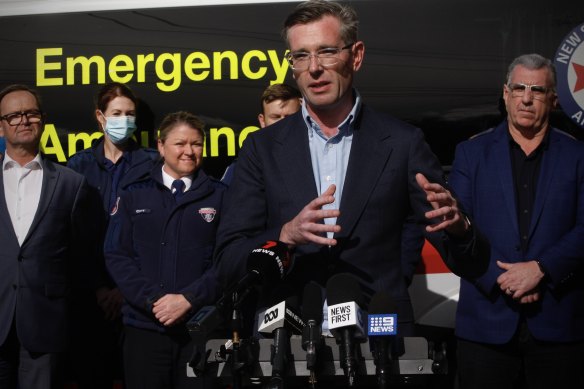This was published 3 years ago
Unprecedented $4.5 billion boost for NSW hospitals, health services
By Lucy Cormack
The Perrottet government will recruit more than 10,000 nurses, doctors and other staff to the state’s hospitals and health services as part of a $4.5 billion boost to the struggling sector.
The funding commitment in the state budget will mark the largest ever boost to the overwhelmed health sector, which has hit crisis point amid chronic understaffing and surging demand throughout the pandemic.

Premier Dominic Perrottet announces more funding for the NSW Ambulance Service on Sunday.Credit: Dean Sewell
Midwives, paramedics, pathologists, pharmacists and allied health professionals will also make up 10,148 full-time recruits under the four-year plan, with more than two-thirds of staff to sign on in the first year, according to the state government.
Overworked nurses and paramedics have walked off the job this year as part of rolling public-sector industrial action to demand better pay and conditions, including improved nurse-to-patient ratios.
Premier Dominic Perrottet said 7674 recruits in the first year will give COVID-fatigued health workers the critical support they need while fast-tracking elective surgeries.
“Everyone in NSW is indebted to our health workers for their selfless efforts throughout the pandemic, remembering for a long time there was no vaccine, and they risked their lives each day to care for patients,” he said.
Health Minister Brad Hazzard said the boost would also lock in health staffing for the state’s pipeline of infrastructure projects, with 110 new hospitals and health facilities underway.
The breakdown of the new workforce will be determined by local health districts based on staffing and patient demand.
The huge investment comes in addition to a $1.76 billion lifeline announced on Sunday for the state’s strained ambulance service to employ more than 1850 extra paramedics and build 30 stations.
Over four years, this funding will also provide an extra 210 ambulance support staff, 52 nurses and eight doctors. NSW Ambulance Commissioner Dominic Morgan said the service had been waiting three decades for such a boost.
NSW Ambulance will be releasing 200 offers of employment on Monday to already qualified eligible paramedics.
Health Services Union national president Gerard Hayes said it was an unprecedented outcome for fatigued paramedics who turn up daily for 16-hour shifts.
“Our members get so frustrated and upset when they can’t be there in time. They will give themselves until there’s nothing left to give,” he said.
Hayes said the HSU was working with the government to develop a professional rates taskforce to establish better pay and recognise the professionalism of paramedics.
The Herald last month revealed a proposal to take non-urgent triple-zero callers to general practitioners or pharmacies in response to unprecedented pressure on the ambulance network.
Worsening pressure on the service emerged as doctors warned that overcrowding in emergency departments was so severe patients were being treated in corridors, while ambulances have been routinely ramped for hours outside hospitals waiting to offload patients.
The premier on Sunday said the record increase in ambulance staff would ensure NSW had more paramedics than anywhere else in the country.
“This is a generational announcement of a generational investment that will set up our state for a brighter future and ensure that people right across NSW, whether you live in metropolitan Sydney or regional NSW ... have the best healthcare possible.”
The funding announcements follow last month’s damning report from a parliamentary inquiry into regional hospitals that heard disturbing allegations of critical staff shortages and inadequate resources leading to significantly poorer health outcomes for patients, including premature deaths.
Perrottet said he welcomed the report but argued regional health had improved since the Coalition took office in 2011 and that work was continuing.
“It’s not a perfect system. We live in a vast state. Many areas are incredibly remote,” he said.
“It’s a balancing act across the board. But I’m very proud of the investments we’ve made. We want to have a system, wherever you live in this great state of ours, you have access to that health care.”
Minister for Regional Health Bronnie Taylor said rural and regional communities would welcome the health workforce staffing boost.
The government has faced a growing tide of industrial unrest this year from teachers, nurses, paramedics and transport workers over a 2.5 per cent public sector wage cap which has failed to keep pace with the cost of living.
Union delegates met on Sunday, vowing to take further industrial action if rights for collective bargaining, “same job, same pay” contracts and a commitment ruling out further privatisation are not guaranteed in the budget.
A report released by the peak body representing unions on Sunday found frontline workers would be $2000-$2500 worse off a year if the wage cap was not lifted.
The premier would not be drawn on whether his government would lift the wage cap in the budget, but said the outcome would be “fair and reasonable”.
Treasurer Matt Kean said the government acknowledged inflationary pressures on wages and would respond further in the coming weeks.
The Morning Edition newsletter is our guide to the day’s most important and interesting stories, analysis and insights. Sign up here.